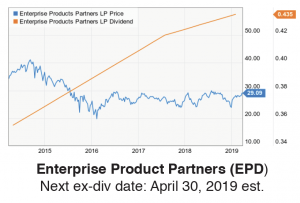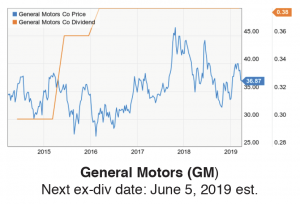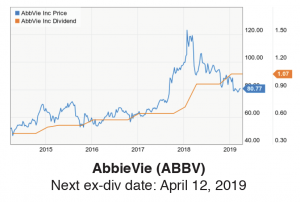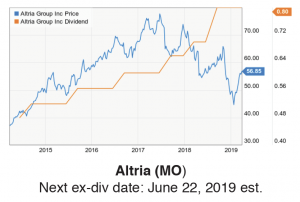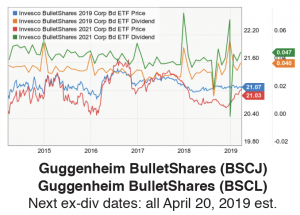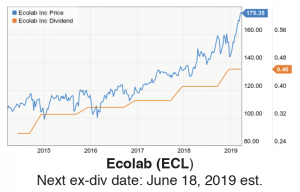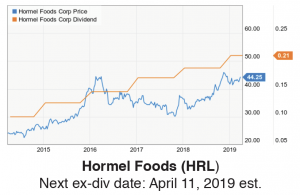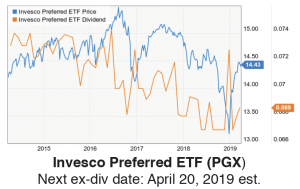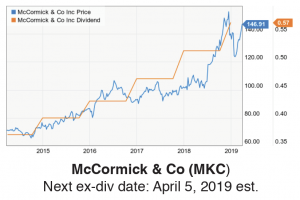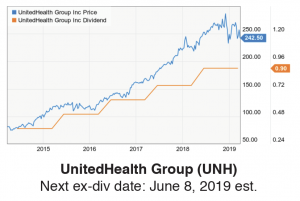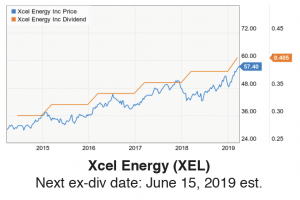In this issue I highlight a company that has been investing in infrastructure assets all over the world. The stock has doubled the return of the S&P 500. And business will only get better.
Cabot Dividend Investor 319
[premium_html_toc post_id="173726"]
Profit from the Great Global Infrastructure Crisis
Have you ever lost power in your house? I lost power for a week a few years ago after Hurricane Sandy. It was unbearable. My wife and son fled to my mother-in-law’s house and I stayed home to mind the fort. I sat in the dark and cold listening to the radio until the battery ran out. When I went out for food and supplies the lines were enormous.
It was shocking how just a few days without the modern conveniences turned my life completely upside down. Basic infrastructure like electricity, water and internet are what makes modern life modern. Without it we live in the Stone Age. And our infrastructure is crumbling.
Infrastructure is defined as the basic physical structures essential to the operation of a society. It includes water systems, power plants, ports, highways and bridges, communication systems and the like. Our infrastructure is like the pulmonary system of a modern society. The American Society of Civil Engineers reviews our 15 infrastructure categories every four years and issues an overall grade. The last was in 2017. The grade was a D+.
Systems get old and need to be renovated or replaced. But governments are always strapped for cash. The same group estimates that this country needs to spend an additional $2 trillion, in addition to what we currently spend, on infrastructure over the next ten years to get our systems up to snuff.
And we’re not alone. Every other developed country has aging systems in desperate need of replacement. It’s even worse in emerging markets where their systems are often woefully insufficient to accommodate growing urban populations and more advanced economies. The G-20’s Global Infrastructure Hub estimates that a global investment of $94 trillion will need to be invested over the next several decades. That’s trillion with a T.
Governments don’t have all those trillions of dollars lying around. The only way to possibly answer the need is with private money. Governments will have to do some investing of course but the bulk of the capital will come from private sources, More and more private firms are building their own infrastructure assets. And governments are partnering with private companies on certain projects as well as selling existing infrastructure assets to private firms to raise money for other projects.
Infrastructure is becoming a hot investment for private funds to the extent that it is almost becoming its own asset class. Limited partnerships, giant sovereign-wealth funds, multilateral and development-finance institutions are raising by some measurements trillions of dollars a year for infrastructure investments.
Amidst this great opportunity the question is where to invest. In this issue I will highlight a company that has been successfully managing a portfolio of infrastructure investments for the last ten years, with great success. The company is already a seasoned hand at plucking the most advantageous assets that provide reliable income and capital appreciation. The company has proved itself to be among the most worthy players in the space.
[highlight_box]What To Do Now: This is a tricky environment. I believe dividend stocks are in the sweet spot of this late stage economic cycle market. The December selloff gave most investors a hangover and increased the appetite for income and recession resistant businesses.
The year-to-date returns aren’t reflecting the new dominance of dividend stocks. But that’s misleading. There was less of a bounce back because those stocks fell a lot less in the December swoon. But returns over the past year accurately reflect the outperformance of dividend payers.
That said, many of the dividend paying defensive studs are trading at high historical valuations. It’s tough to buy a defensive stock after a great year and near the 52-week high. At the same time, the more cyclical names are a bet on an improving external environment. It’s not an easy call where to put new money.
Fortunately, having recently started as Chief Analyst of this newsletter, I have a strong backlog of many stocks I’ve been following for years. And I have been able to pluck rare value stocks that rise above the current conundrum. Altria (MO), AbbVie (ABBV) and Enterprise Product Partners (EPD) are all fantastic companies that offer deep discounts, high yields and downside protection. The longer-term prognosis is excellent and these stocks are great buys here.
There are also two other nice opportunities in the portfolio right now. American Express (AXP) operates in an obscenely profitable business with strong tailwinds over the intermediate and longer term. It also sells at a cheap valuation and has fantastic momentum. NextEra Energy (NEE), which offers both steady, reliable income and growth from its leadership in clean energy might be the best utility stock of all time. The momentum is spectacular and the stock still sells at a valuation well below the five year average.[/highlight_box]
Featured Buy
Brookfield Infrastructure Partners L.P. (BIP)
Bermuda-based Brookfield Infrastructure Partners L.P. (BIP) owns and operates infrastructure assets all over the world. The company particularly focuses on high quality, long-life properties that generate stable cash flows, have low maintenance expenses and are virtual monopolies with high barriers to entry.
BIP was established by world renowned, Toronto-based asset manager Brookfield Asset Management (BAM) in 2008 to take advantage of the infrastructure build-out. BAM still acts as manager and General Partner and owns a 30% stake in BIP.
While infrastructure investing has recently started to boom, Brookfield was early to the party. BIP has had the foresight to scour the globe and pluck the very best assets before much of the potential competition got wise to the phenomenon. It now has valuable partners and contacts all over the world that enable the company to find profitable projects as they become available.
It’s a great business but you really have to know what you’re doing. These guys apparently do.
Since 2009 the partnership has grown funds from operations (FFO), the key determinant of cash flow for MLPs, by an average of 16% per year. Over the last ten years the stock has returned 632% (with dividends reinvested) for an average 22% annual return, double the return of the S&P 500 over the same period.
Brookfield has a current portfolio with 2000 assets in 30 countries on five continents. It is well diversified geographically with roughly 25% in North America, 30% South America, 25% Europe and 20% Asia Pacific.
Assets include:
• Toll roads in South America
• Telecom towers in France
• Railroads in Australia
• Natural gas pipelines and storage in North America
• Utilities in Brazil
• Ports in Europe, Australia and North America
• Date centers on three continents
The assets are diverse and well chosen for reliable cash flow and profitability. They are vital properties that continue to generate cash in any economy and are tailor made to generate dividend income.
Payout
As a Master Limited Partnership (MLP) BIP pays no income tax at the corporate level provided the bulk of earnings are paid out to shareholders in the form of distributions. As a result, it has a higher payout than most regular dividend stocks. The current yield is 4.95% ($0.5025 per quarter and $2.01 per year) and the annual distribution has increased at an average 10.4% annual rate over the last five years. The company plans annual dividend growth of 5% to 9% going forward.
The payout is well supported as the current payout ratio is just 63.5% of FFO, which is very low for an MLP. The low payout ratio is actually a big key to future growth as well. It enables Brookfield to retain its own funds to invest in growth.
Growth
In order to take advantage of the abundance of opportunities likely to become available in the quarters and years ahead, Brookfield has developed a superior strategy for raising the necessary capital to pursue the best investments and grow earnings.
MLP’s are not a perfect structure because most pay out all the earnings in distributions and have to either issue new stock shares or borrow money to get funds for expansion. The strategy can dilute shareholder value and raise too much debt over time. In order to maintain the strong balance sheet with investment grade rated debt and maintain shareholder value, Brookfield shifted gears on its strategy last year.
To raise capital it is now relying on asset rotation in addition to retained earnings. The idea is to sell mature assets when returns have maximized and use the proceeds for high return projects. It started last year when the company sold lower performing assets to invest in ones with higher returns. The temporary adjustment caused a rare bad year for stock returns as earnings faltered because of the sale before it could get the new assets on line.
Those new assets will bolster earnings this year, which should hopefully reignite the stock. About 80% to 85% or revenues are in US dollars or dollar hedged. This is a company and stock that is in the right place at the right time with a business model of proven success in the sector. It will be added to the High Income Tier as a “BUY”.
Brookfield Infrastructure Partners LP (BIP)
Brookfield Infrastructure Partners LP (BIP)
Security Type: Master Limited Partnership (MLP)
Industry: Infrastructure
Price: 40.63
52-week range: $32.26 - $42.54
Yield: 5%
Profile: BIP was created by Brookfield Asset Management to own and operate infrastructure assets throughout the world.
Positives
• The stock has yielded better results than any other infrastructure play.
• Most of cash flow is secured by regulated businesses and long term contracts.
• Growth opportunities should abound as the world will have to spend trillions on new projects.
Risks
• Investors could sour on its international scale as the global economy deteriorates.
• It operates in countries where the political and regulatory environments can be uncertain.
• Competition for high quality assets is increasing.
Portfolio at a Glance
Prices as of mid-afternoon on March 27, 2019
Portfolio Updates
High Yield Tier
The investments in our High Yield tier have been chosen for their high current payouts. These ?investments will often be riskier or have less capital appreciation potential than those in our other ?two tiers, but they’re appropriate for investors who want to generate maximum income from their? portfolios right now.
HOLD – Community Health Trust (CHCT 36 – yield 4.5%) – This smaller, higher growth healthcare property REIT has been everything good about REITs lately on steroids. It’s outperformed the REIT index and the overall market in every measurable period over the last five years (including a 49% over the last year) except for the last month. The stock sputtered on the disappointing earnings announcement but has since regained its footing. It looks like the good momentum has resumed and it’s still off the 52-week high.
BUY - Enterprise Product Partners (EPD 29 – yield 6.1%) – This world class American energy infrastructure company may be on the verge of a breakout. Because of lagging performance in the energy industry and a huge focus on investments in the future over the past several years, the stock has been range-bound for the last three years. A move over $30 per share (now $29.10) would signal a breakout. There are reasons it may do that. The energy sector may finally be waking up. It’s one of the best performing sectors so far this year. Enterprise’s performance justifies it; operating cash flow increased 31% last year. And it embarked on a huge growth plan in 2017 that will start coming to fruition this year as five new major projects will come into service. Stay tuned.
SELL – General Motors (GM 37 – yield 4.1%) – North American car sales are declining after many years of expanding. The china trade issues continue. And investors are worried about the next recession. In short, the external environment is lousy. But GM is a far better car company than before with a solid balance sheet that pays a high dividend and sells at a microscopic valuation. Meanwhile, the company continues to invest heavily in the future in self driving and electric cars. During the next cycle this could be a great stock to buy, but not now. It’s lost its post-selloff momentum and has fallen steadily from the $40 level all month. I am selling the remaining 1/3 position at about a 30% profit while the getting is good.
HOLD – STAG Industrial (STAG 29 – yield 5.2%) – STAG is a great REIT and one of the best in the promising Industrial space. It has consistently outperformed both the overall market and the REIT index. The stock just continues to march on and just made a new all time high at $29.34. It’s a good market for REITs but the market seems to have a special affection for this one. There is probably no bad time to buy this stock but I just hate to buy something after a fantastic year at the 52-week and all time high. It’s been at this level before. Let’s see if it can break out. For now it’s a HOLD.
Dividend Growth Tier
To be chosen for the Dividend Growth tier, investments must have a strong history of dividend increases and indicate both good potential for and high prioritization of continued dividend growth.
BUY – AbbVie (ABBV 80 – yield 5.4%) – AbbVie is cheap now, at 34% below its 2018 high, because of increasing overseas competition for its top selling drug Humira. The drug accounts for 60% of revenues and AbbVie has not yet proven that it can overcome the lost revenues from Humira. I believe that between its newly launched drugs and its pipeline, which may launch two new blockbuster drugs this year, the company can easily overcome falling Humira sales overseas. I bought Eli Lilly in 2012 when it was in a similar situation and the stock was slumping. But Lilly has a strong pipeline and record of stellar management, like AbbVie. LLY has returned 300% since. I see a similar situation for ABBV. It may take some time but the stock pays you 5.4% while you wait.
BUY – Altria (MO 57 – yield 5.7%) – Investor sentiment for the cigarette maker seems to have turned the corner since the ugly days of late last year. The stock is up 15% for the year so far. It helped that the company reported solid earnings, which showed it can offset cigarette volume declines by raising prices on its flagship Marlboro brand. The news on new acquisitions of marijuana company Cronos (CRON) and E-cigarette maker JUUL have been encouraging. And the high dividend yield is appealing to investors. As far as noise from the regulators is concerned, many are realizing that it would take years and years in court to achieve anything like a menthol ban and by then Altria can adjust, as it always has. Meanwhile, the stock is trending consistently higher.
BUY – American Express (AXP 109 – yield 1.3%) – The credit card business is basically a license to print money. AXP stock has returned investors 750% over the last ten years. Visa (V) and Mastercard (MA) have returned over 1000% each over the same period. And the trends still look good. It is increasingly a cashless world and the size of the global middle class is expanding at a breakneck pace. AXP has been growing its business, and earnings per share grew at 24% last year. The momentum and the stock chart look great. I still have concerns about the global economy and I will continue to watch that. But this stock sells at just 12.5 times expected 2019 earnings and the stock seems to want to go higher. I’m raising it to a “BUY”.
Safe Income Tier
The Safe Income tier of our portfolio holds long-term positions in high-quality stocks and other investments that generate steady income with minimal volatility and low risk. These positions are appropriate for all investors, but are meant to be held for the long term, primarily for income—don’t buy these thinking you’ll double your money in a year.
BUY- Invesco BulletShares 2019 Corporate Bond ETF (BSCJ 21 – yield 1.9%)
BUY – Invesco BulletShares 2021 Corporate Bond ETF (BSCL 21 – yield 2.4%)
It’s nice to have something in the portfolio that isn’t vulnerable to a market downturn. These funds fit the bill. The yield isn’t great but it’s something. As long as there are a lot of risks out there and we seem to be in the late stages of the economic cycle these short-term fixed income funds are worth holding. It’s also a great place to park money to tap in the event of a market downturn while still getting a decent return.
HOLD – Consolidated Edison (ED 85 – yield 3.4%) – This NYC area utility is up 6% since announcing earnings. I’ll be completely honest. The only thing I like about this stock right now is the momentum. It moved past the 52-week high and still looks strong. I think the key driver right now is that the specter of higher interest rates has diminished. For now it’s still a hold.
HOLD – Ecolab (ECL 175 – yield 1.0%) – This chemical and sanitation company just keeps rolling on. After delivering stellar market beating performance over the past few years it just rolls on. It’s up almost 20% so far this year and 4.5% in the past month. Momentum is strong and the company is guiding for earnings growth of 10% to 14% this year. I think this stock still has some room to run. It’s a defensive stud that the market loves right low, enjoy.
HOLD – Hormel Foods (HRL 44 – yield 1.9%) – I sold half of the position in the food stalwart a couple of weeks ago. The stock has performed extremely well over the past year, up 35% versus 7.6% for the overall market. However, the stock is significanlthy underperforming the market so far this year. Other defensive names in the portfolio are faring much better. I think the fact that Hormel faces risks with the possibility of increased China tariffs is holding it back. The stock has perked up however over the past month and I will continue to hold it with a watchful eye.
BUY – Invesco Preferred ETF (PGX 14 – yield 5.8%) – This is a great place to diversify away from stocks and bonds and get a high yield in a portfolio of preferred stocks. After some rough performance last year the market has seemingly decided that it likes this asset class again. Price action has been great and the yield is fantastic. On the basis of diversification and yield it’s a BUY.
HOLD – McCormick & Co (MKC 147 - yield 1.5%) – The spice king reported better than expected earnings this week and the stock is reignited. It posted earnings per share of $1.12 versus the expected $1.03 and last year’s $1.00. That’s a 12% bump in the fiscal first quarter, not bad growth for a defensive player with no recent acquisitions driving the bottom line. After being rudely interrupted by a slightly disappointed earnings report last quarter, the stock has resumed its ascent and the pace is increasing following this week’s earnings. Valuations are stretched at this point so it isn’t rated a buy. But momentum reigns supreme right now so the stock is still a HOLD.
BUY – NextEra Energy (NEE 194 – yield 2.3%) – This best in class stock utility stock offers both steady income and a lot more growth than the average utility. This juggernaut just keeps on rising. It broke through the 52-week high and has solid momentum from here. It’s a good time in the market for Utilities in general and a great time for the best ones. Its Florida Power and Light business operates in a friendly regulatory environment with a growing population. Its NextEra Energy Resources clean energy business offers solid growth as far as the eye can see. Although the stock is at new highs it still sells at a price/earnings ratio well below the five-year average and looks divine from a technical standpoint.
HOLD – UnitedHealth Group (UNH 241 – yield 1.5%) – The stock surged off its bottom two weeks ago but then fell right back. UNH has established a clear pattern of underperformance this year. It’s down over 5% in the past week, 7% in the past month and 2% so far this year while the market is up over 15% year-to-date. There really isn’t any operational issue that I can find. The company is doing well and should continue to deliver solid earnings growth. It must be all this healthcare talk in Washington. The overall healthcare sector is the worst performing so far in 2019. I don’t believe this government will get anything done but investors clearly are spooked by the talk of it, which will only increase as the election gets closer. I won’t fight the tape and I’m lowering the rating to HOLD” based on technical deterioration.
HOLD – Xcel Energy (XEL 57 – yield 2.5%) – The stock is pricey here but momentum rules in the near term. The stock blew right past the 52-week high and still has more upside momentum. Utilities have been the best performing sector of the market over the past year but Xcel has nearly doubled the index return of the period. Alternative energy is hot stuff and a great compliment to a currently favored sector. We’ll see how long the uptrend lasts, but for now enjoy the ride.
Last price as of mid-afternoon on March 27, 2019
Dividend Calendar
Ex-Dividend Dates are in RED and italics. Dividend Payments Dates are in GREEN. Confirmed dates are in bold, all other dates are estimated. See the Guide to Cabot Dividend Investor for an explanation of how dates estimated.
The Yield Curve Conundrum
The market had a scare last week. The yield curve inverted and the Dow Jones fell over 400 points in one day on fears of a deteriorating economy.
An inverted yield curve occurs when longer term interest rates fall below short term interest rates. Of all the numbers that prognosticators throw around, this one has been the most reliable portent of things to come. The yield curve inversion has preceded something like eight of the last eight recessions. So it needs to be taken seriously.
Historically, lower longer term rates reflect the fact that the credit markets anticipate slower economic activity going forward. And they are almost always right. But it’s different this time because credit markets are not setting the interest rates. Central bankers are.
In the aftermath of the financial crisis the Fed intervened to stimulate the economy in an unprecedented manner, holding short term rates near zero for seven years and pumping more than $4 trillion into the banking system through its numerous bond buying programs. Central banks in other developed economies followed suit and in some cases went even farther.
In the US, we are getting off the Fed juice. The bond buying programs have ceased and the Fed is rolling back its balance sheet. Short term rates have been raised from 0% to 0.25% to 2.25% since late 2015. But central bankers in Europe and Japan haven’t gotten off the artificial stimulus drug. They never made it to the Betty Ford Clinic.
Interest rates are still below zero in some cases. As a result, our longer term rates are being artificially depressed. Normally, longer term interest rates rise along with the demand for money in a strong economy. But bond issuers don’t have to pay higher rates because there is no competition. Alternative bond investments overseas are paying next to nothing. Why pay more interest when you don’t have to?
At the same time, the Fed has been raising the short term Fed funds rate. History dictates that at this point in an economic cycle rates need to be raised to prevent the economy from overheating and inflation from getting out of hand. But in this case the Fed raised rates mostly so they would have dry powder to lower them again if the economy turns south.
In short, center bankers have skewed the credit markets and squelched their voice.
Even if the economy is spiraling toward recession, you can’t tell from the credit markets because they’re all messed up. The once reliable yield curve indicator has been rendered virtually useless by central bank intervention.
The good news is that there is still no indication that the economy is tanking or will in the foreseeable future. And the current conundrum is making the environment even better for dividend stocks. The economy is still solid and there aren’t rising bond rates that will compete for investment capital. Central bankers are giving us a big fat present, for now.
[premium_html_footer]
Your next issue will be published April 24, 2019
Cabot Wealth Network • 176 North Street • Salem MA 01970 • 978-745-5532
Neither Cabot Wealth Network nor our employees are compensated by the companies whose stocks we recommend. Sources of information are believed to be reliable, but are in no way guaranteed to be complete or without error. Recommendations, opinions or suggestions are given with the understanding that subscribers acting on the information assume all risks. © Cabot Wealth Network. Copying and/or electronic transmission of this report is a violation of U.S. copyright law. For the protection of our subscribers, if copyright laws are violated, the subscription will be terminated. To subscribe or for information on our privacy policy, call 978-745-5532, visit www.cabotwealth.com or write to support@cabotwealth.com.
[/premium_html_footer]






